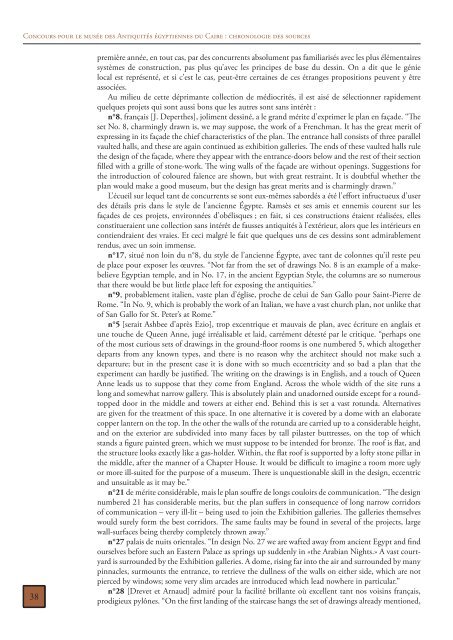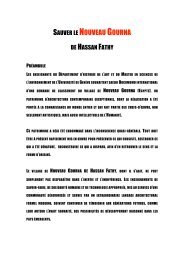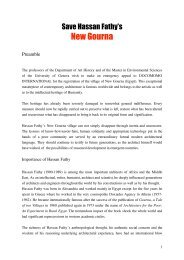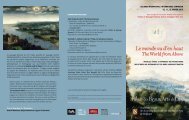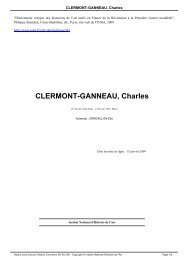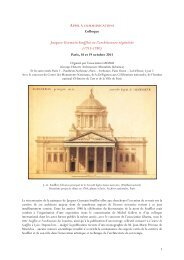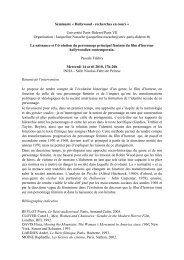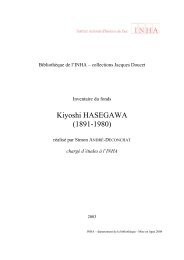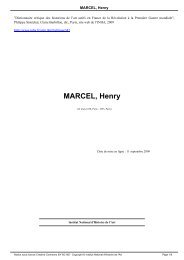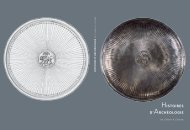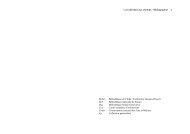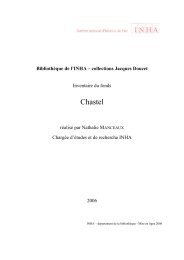Chronologie de la construction du Musée - Invisu
Chronologie de la construction du Musée - Invisu
Chronologie de la construction du Musée - Invisu
- No tags were found...
You also want an ePaper? Increase the reach of your titles
YUMPU automatically turns print PDFs into web optimized ePapers that Google loves.
Concours pour le musée <strong>de</strong>s Antiquités égyptiennes <strong>du</strong> Caire : chronologie <strong>de</strong>s sources<br />
38<br />
première année, en tout cas, par <strong>de</strong>s concurrents absolument pas familiarisés avec les plus élémentaires<br />
systèmes <strong>de</strong> <strong>construction</strong>, pas plus qu’avec les principes <strong>de</strong> base <strong>du</strong> <strong>de</strong>ssin. On a dit que le génie<br />
local est représenté, et si c’est le cas, peut-être certaines <strong>de</strong> ces étranges propositions peuvent y être<br />
associées.<br />
Au milieu <strong>de</strong> cette déprimante collection <strong>de</strong> médiocrités, il est aisé <strong>de</strong> sélectionner rapi<strong>de</strong>ment<br />
quelques projets qui sont aussi bons que les autres sont sans intérêt :<br />
n°8, français [J. Deperthes], joliment <strong>de</strong>ssiné, a le grand mérite d’exprimer le p<strong>la</strong>n en faça<strong>de</strong>. “The<br />
set No. 8, charmingly drawn is, we may suppose, the work of a Frenchman. It has the great merit of<br />
expressing in its faça<strong>de</strong> the chief characteristics of the p<strong>la</strong>n. The entrance hall consists of three parallel<br />
vaulted halls, and these are again continued as exhibition galleries. The ends of these vaulted halls rule<br />
the <strong>de</strong>sign of the faça<strong>de</strong>, where they appear with the entrance-doors below and the rest of their section<br />
filled with a grille of stone-work. The wing walls of the faça<strong>de</strong> are without openings. Suggestions for<br />
the intro<strong>du</strong>ction of coloured faïence are shown, but with great restraint. It is doubtful whether the<br />
p<strong>la</strong>n would make a good museum, but the <strong>de</strong>sign has great merits and is charmingly drawn.”<br />
L’écueil sur lequel tant <strong>de</strong> concurrents se sont eux-mêmes sabordés a été l’effort infructueux d’user<br />
<strong>de</strong>s détails pris dans le style <strong>de</strong> l’ancienne Égypte. Ramsès et ses amis et ennemis courent sur les<br />
faça<strong>de</strong>s <strong>de</strong> ces projets, environnées d’obélisques ; en fait, si ces <strong>construction</strong>s étaient réalisées, elles<br />
constitueraient une collection sans intérêt <strong>de</strong> fausses antiquités à l’extérieur, alors que les intérieurs en<br />
contiendraient <strong>de</strong>s vraies. Et ceci malgré le fait que quelques uns <strong>de</strong> ces <strong>de</strong>ssins sont admirablement<br />
ren<strong>du</strong>s, avec un soin immense.<br />
n°17, situé non loin <strong>du</strong> n°8, <strong>du</strong> style <strong>de</strong> l’ancienne Égypte, avec tant <strong>de</strong> colonnes qu’il reste peu<br />
<strong>de</strong> p<strong>la</strong>ce pour exposer les œuvres. “Not far from the set of drawings No. 8 is an example of a makebelieve<br />
Egyptian temple, and in No. 17, in the ancient Egyptian Style, the columns are so numerous<br />
that there would be but little p<strong>la</strong>ce left for exposing the antiquities.”<br />
n°9, probablement italien, vaste p<strong>la</strong>n d’église, proche <strong>de</strong> celui <strong>de</strong> San Gallo pour Saint-Pierre <strong>de</strong><br />
Rome. “In No. 9, which is probably the work of an Italian, we have a vast church p<strong>la</strong>n, not unlike that<br />
of San Gallo for St. Peter’s at Rome.”<br />
n°5 [serait Ashbee d’après Ezio], trop excentrique et mauvais <strong>de</strong> p<strong>la</strong>n, avec écriture en ang<strong>la</strong>is et<br />
une touche <strong>de</strong> Queen Anne, jugé irréalisable et <strong>la</strong>id, carrément détesté par le critique. “perhaps one<br />
of the most curious sets of drawings in the ground-floor rooms is one numbered 5, which altogether<br />
<strong>de</strong>parts from any known types, and there is no reason why the architect should not make such a<br />
<strong>de</strong>parture; but in the present case it is done with so much eccentricity and so bad a p<strong>la</strong>n that the<br />
experiment can hardly be justified. The writing on the drawings is in English, and a touch of Queen<br />
Anne leads us to suppose that they come from Eng<strong>la</strong>nd. Across the whole width of the site runs a<br />
long and somewhat narrow gallery. This is absolutely p<strong>la</strong>in and unadorned outsi<strong>de</strong> except for a roundtopped<br />
door in the middle and towers at either end. Behind this is set a vast rotunda. Alternatives<br />
are given for the treatment of this space. In one alternative it is covered by a dome with an e<strong>la</strong>borate<br />
copper <strong>la</strong>ntern on the top. In the other the walls of the rotunda are carried up to a consi<strong>de</strong>rable height,<br />
and on the exterior are subdivi<strong>de</strong>d into many faces by tall pi<strong>la</strong>ster buttresses, on the top of which<br />
stands a figure painted green, which we must suppose to be inten<strong>de</strong>d for bronze. The roof is f<strong>la</strong>t, and<br />
the structure looks exactly like a gas-hol<strong>de</strong>r. Within, the f<strong>la</strong>t roof is supported by a lofty stone pil<strong>la</strong>r in<br />
the middle, after the manner of a Chapter House. It would be difficult to imagine a room more ugly<br />
or more ill-suited for the purpose of a museum. There is unquestionable skill in the <strong>de</strong>sign, eccentric<br />
and unsuitable as it may be.”<br />
n°21 <strong>de</strong> mérite considérable, mais le p<strong>la</strong>n souffre <strong>de</strong> longs couloirs <strong>de</strong> communication. “The <strong>de</strong>sign<br />
numbered 21 has consi<strong>de</strong>rable merits, but the p<strong>la</strong>n suffers in consequence of long narrow corridors<br />
of communication – very ill-lit – being used to join the Exhibition galleries. The galleries themselves<br />
would surely form the best corridors. The same faults may be found in several of the projects, <strong>la</strong>rge<br />
wall-surfaces being thereby completely thrown away.”<br />
n°27 pa<strong>la</strong>is <strong>de</strong> nuits orientales. “In <strong>de</strong>sign No. 27 we are wafted away from ancient Egypt and find<br />
ourselves before such an Eastern Pa<strong>la</strong>ce as springs up sud<strong>de</strong>nly in «the Arabian Nights.» A vast courtyard<br />
is surroun<strong>de</strong>d by the Exhibition galleries. A dome, rising far into the air and surroun<strong>de</strong>d by many<br />
pinnacles, surmounts the entrance, to retrieve the <strong>du</strong>llness of the walls on either si<strong>de</strong>, which are not<br />
pierced by windows; some very slim arca<strong>de</strong>s are intro<strong>du</strong>ced which lead nowhere in particu<strong>la</strong>r.”<br />
n°28 [Drevet et Arnaud] admiré pour <strong>la</strong> facilité bril<strong>la</strong>nte où excellent tant nos voisins français,<br />
prodigieux pylônes. “On the first <strong>la</strong>nding of the staircase hangs the set of drawings already mentioned,


